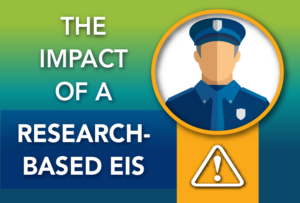Early Alerts, Timely Action: The Impact of a Research-Based EIS
Posted
October 23, 2023
Share:

In an ever-evolving society, the roles and expectations placed on law enforcement officers – including how they engage and interact with the communities they serve – are continually changing. The same is true for how they are managed and supported for optimal on-the-job performance. As part of that infrastructure, the right early intervention system can become an indispensable tool for agency leaders aiming to discern and act on any potentially problematic patterns in officer behavior.
Such a system would be designed to identify and address these patterns before they develop into major incidents, ensuring the public’s safety and the officer’s well-being. Yet, the thoughtful implementation of a successful EIS requires careful consideration, adept change management, and a comprehensive understanding of an agency’s culture.
This summer, Benchmark Analytics presented the second installation of their Data Dialogue webinar series, led by CEO Ron Huberman, titled “Navigating EIS Alerts: Mastering the Right Approach for Your Agency.” Among the panel of participants were Benchmark’s Chief Research Officer, Nick Montgomery, Vice President of Data Science, Dr. Ugochi Jones, and Director of Data and Enterprise Analytics, Riley Maloney.
Four Approaches to EIS Alerts
Riley Maloney kicked off the discussion by outlining the four prevalent strategies that agencies employ in response to EIS alerts, signaling that an officer might need intervention. These strategies included:
- Centralized: A chosen group of department leaders addresses each alert. Although efficient, this method can seem detached in larger agencies.
- Centralized Review: Here, a dedicated risk management team supervises all alerts. While this approach leverages specialized knowledge, it can inadvertently create a divide between the unit and the broader group of officers, possibly engendering an “us vs. them” attitude.
- Decentralized: Here, front-line supervisors are responsible for responding to their officers’ alerts. While fostering close bonds, this might result in inconsistencies due to diverse supervisory styles.
- Capacity Building: This is a combined effort where the risk management team collaborates with supervisors to provide training and expertise in deciphering alerts. It promises consistency and local responsibility, connecting various stakeholders and fostering trust.
Riley observed that the efficacy of each model is contingent on the agency’s internal intervention mechanisms. More and more agencies are turning to Benchmark – with its First Sign® Early Intervention and C.A.R.E. platforms – and as a result, these agencies can discern the most fitting approach for their organizational design.
“In each of these systems, it’s vital to remember that an early intervention system’s strength lies in the interventions allocated in response to an alert. If an alert arises but is not acted upon, it’s futile. Benchmark dedicates significant time collaborating with agencies during the rollout phase to identify which of the four methods, or perhaps a new one, is most suited for their specific context. The aim is to determine how an agency can respond most effectively to an EIS alert.”
The Importance of Documentation
Often, in decentralized models, sergeants – due to their close ties with officers – are the first responders to EIS alerts. Yet, some supervisors might hesitate in documenting interventions, choosing instead to address matters informally. Despite good intentions, more documentation is needed to ascertain the efficacy of these interventions.
The panel acknowledged the importance of maintaining productive relationships with officers. However, they also emphasized that thorough documentation is indispensable for gauging success.
Challenges and Solutions in EIS Implementation
The discussion evolved toward potential obstacles in implementing an early intervention system. For instance, in larger agencies, supervising officers may become disconnected from frontline officers, complicating meaningful interventions. Additionally, some supervisors might need more training to formally document interventions due to existing cultural norms within the agency or lack of training.
Benchmark’s Chief Research Officer Nick Montgomery championed the capacity-building model, underscoring its balance between immediate alert responses and aiding supervisors in interpreting data and devising meaningful interventions.
“In any department, promotions are inevitable. Officers ascend to the rank of sergeants, and sergeants get promoted to lieutenants, among other shifts. There will be departures and new inductions, signifying change. This capacity-building method isn’t just about managing this flux. It’s centered on empowering individuals with the requisite skills to flourish in this dynamic setting. This isn’t confined to logistical details but extends to enhancing communication with officers, interpreting data accurately, and formulating robust strategies. Ultimately, it prepares the department for sustained improvement.”
Dr. Ugochi Jones delved into the shortcomings of casual interventions and emphasized the need for careful documentation. “In my discussions with supervisors, many who aren’t deeply engaged with the system (First Sign) still favor informal intervention. While they value effective communication when addressing potential issues among officers, they feel documentation makes it overly formal. We must consider this sentiment in our approach.”
Dr. Jones stressed the importance of constructive, data-driven exchanges with officers and the imperative to shift the perception and reality of interventions as a punitive measure to a supportive tool for officers. Meanwhile, Riley Maloney advocated for the inclusion of diverse stakeholders when shaping EIS policies, positing that this broad-based approach bolsters system trust.
The Path Forward
Effective communication and supervisory advancements are crucial. Benchmark’s First Sign is the only peer-to-peer, research-backed early intervention system — and has the potential to become a force multiplier for positive organizational transformation, with its implementation varying from agency to agency. The consensus among the panel was clear: for agencies with over a hundred officers, the capacity-building approach appears to be the most fitting. Meanwhile, smaller agencies benefit from a centralized or centralized review approach. However, the panel emphasized that agencies should not choose an approach based solely on size.
No single method can achieve widespread organizational change. Successful implementation requires a comprehensive strategy, strong stakeholder engagement, and the careful integration of technology.
Related Posts
Ready to Experience the Benchmark Difference?
Benchmark Analytics and its powerful suite of solutions can help you turn your agency’s challenges into opportunities. Get in touch with our expert team today.



